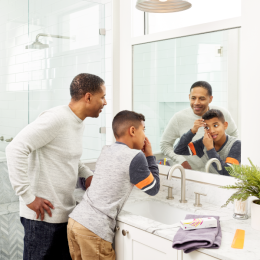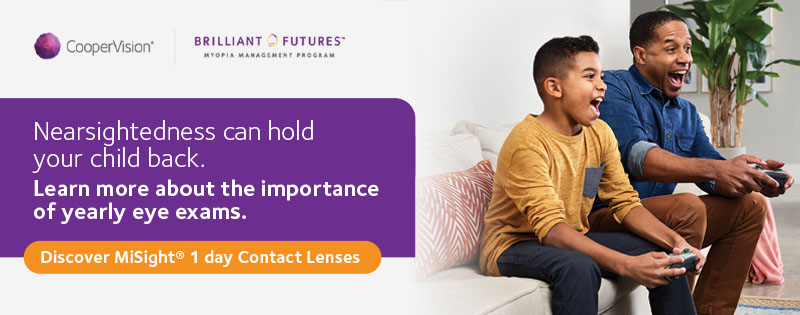Did you know that more than 40 percent of Americans have myopia (also known as nearsightedness)1? This vision problem can develop and worsen over time as a child grows and can even be influenced by factors such as genetics2, increased screen time, and less time playing outdoors3. CooperVision’s Brilliant Futures™ Myopia Management Program with MiSight® 1 day contact lenses are the first and only soft contact lenses FDA approved* to slow the progression of myopia in children age 8-12 at initiation of treatment.†4 To find out if MiSight® 1 day contact lenses are a fit for your child, talk to your Eye Care Practitioner (ECP) and learn more about myopia management at coopervision.com/myopia-management!
*Indications and Important Safety Information. Rx only. Results may vary.
ATTENTION: Reference the Patient Information Booklet for a complete listing of Indications and Important Safety Information. Indication: MiSight® 1 day (omafilcon A) soft (hydrophilic) contact lenses for daily wear are indicated for the correction of myopic ametropia and for slowing the progression of myopia in children with non-diseased eyes, who at the initiation of treatment are 8-12 years of age and have a refraction of -0.75 to -4.00 diopters(spherical equivalent) with ≤ 0.75 diopters of astigmatism. The lens is to be discarded after each removal. Warnings: Problems with contact lenses could result in serious injury to the eye. Do not expose contact lenses to water while wearing them. Under certain circumstances MiSight® lenses optical design can cause reduced image contrast/ghosting/halo/glare in some patients that may cause difficulties with certain visually-demanding tasks. Precautions: Daily wear single use only. Patient should always dispose when lenses are removed. No overnight wear. Patients should exercise extra care if performing potentially hazardous activities. Adverse events: Including but not limited to infection/inflammation/ulceration/abrasion of the cornea, other parts of the eye or eyelids. Some of these adverse reactions can cause permanent or temporary loss of vision. If you notice any of the stated in your child, immediately have your child remove the lenses and contact your eye care professional. †Compared to a single vision 1 day lens over a 3 year period.
References:
1.Holden BA, et al. Global Prevalence of Myopia and High Myopia and Temporal Trends from 2000 through 2050. Ophthalmology. 2016;123(5):1036-42.
2.Mutti DO, Mitchell GL, Moeschberger ML, Jones LA, Zadnik K. Parental myopia, near work, school achievement, and children’s refractive error. Invest Ophthalmol Vis Sci. 2002;43(12):3633-3640. doi:10.1001/jamaophthalmol.2020.0412
3.Huang HM, Chang DS, Wu PC. The Association between Near Work Activities and Myopia in Children-A Systematic Review and Meta-Analysis. PLoS One. 2015;10(10):e0140419. Published 2015 Oct 20. doi:10.1371/journal.pone.0140419
4.Chamberlain P, et al. A 3-year randomized clinical trial of MiSight® lenses for myopia control. Optom Vis Sci. 2019; 96(8):556-567.












